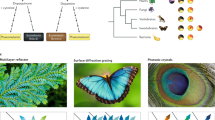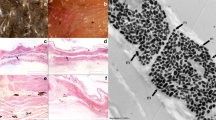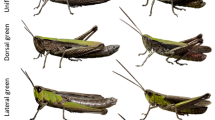Abstract
THE Lepidoptera, with their frequent examples of highly specialized cryptic coloration, have been used extensively for experiments on the various aspects of evolution. More marked evolutionary adjustments have in fact been witnessed in these than in any other natural order. Thus J. B. S. Haldane1 showed that in the Manchester district between the years 1848 and 1898, the jet-black form of the peppered moth (Biston betularia f. carbonaria) had an approximate 30 per cent advantage over pale lichen-like individuals, which were the only ones known there until the middle of the last century. Nor is this occurrence unique among the Lepidoptera of Britain. About fifty other species are, at the present time, in the process of changing their populations from light individuals to black in large areas of England.
This is a preview of subscription content, access via your institution
Access options
Subscribe to this journal
Receive 51 print issues and online access
$199.00 per year
only $3.90 per issue
Buy this article
- Purchase on Springer Link
- Instant access to full article PDF
Prices may be subject to local taxes which are calculated during checkout
Similar content being viewed by others
References
Haldane, J. B. S., Trans. Camb. Phil. Soc., 23, 26 (1924).
Jones, E. W., Rev. Bry. et Lich., 21, 1–2 (1952).
Author information
Authors and Affiliations
Rights and permissions
About this article
Cite this article
KETTLEWELL, H. Recognition of Appropriate Backgrounds by the Pale and Black Phases of Lepidoptera. Nature 175, 943–944 (1955). https://doi.org/10.1038/175943a0
Issue Date:
DOI: https://doi.org/10.1038/175943a0
This article is cited by
-
Colour change and behavioural choice facilitate chameleon prawn camouflage against different seaweed backgrounds
Communications Biology (2019)
-
Avian vision models and field experiments determine the survival value of peppered moth camouflage
Communications Biology (2018)
-
Pigmentation plasticity enhances crypsis in larval newts: associated metabolic cost and background choice behaviour
Scientific Reports (2017)
-
Improvement of individual camouflage through background choice in ground-nesting birds
Nature Ecology & Evolution (2017)
-
Shape, colour plasticity, and habitat use indicate morph-specific camouflage strategies in a marine shrimp
BMC Evolutionary Biology (2016)
Comments
By submitting a comment you agree to abide by our Terms and Community Guidelines. If you find something abusive or that does not comply with our terms or guidelines please flag it as inappropriate.



